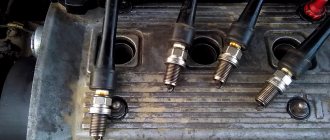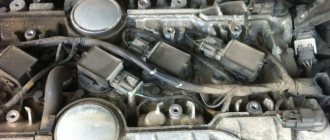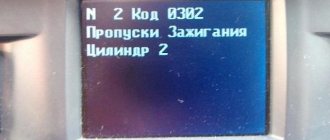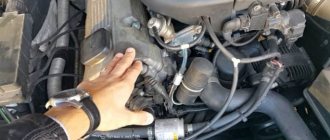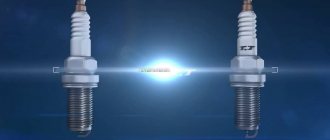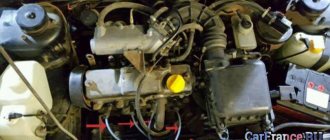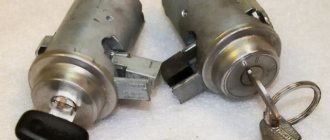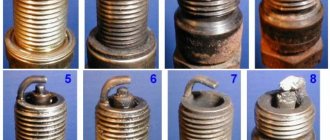The electronic on-board computer is equipped with a function to inform the driver about emerging problems in the vehicle systems. Information is provided through error codes, where each code indicates a specific failure or problem. Therefore, guided by the received codes, you can quickly find the source of the breakdown or incorrect operation and eliminate it. However, “old-style” cars do not have an ECU, so it will not be easy to look for errors in the operation of various systems. At the same time, more and more questions among owners of old and new car models are caused by errors with codes p0300, p0301 and p0302. What is the reason for this interest and why is it so difficult to identify the causes of these errors? Now let’s try to figure it out.
What are these errors?
Codes p0300, p0301 and p0302 indicate failures in the ignition sequence. Their characteristic stands for “random multiple misses in cylinders.” If you use a special device for engine diagnostics, it will display the phrase “Random cylinder misfire detection system.”
Why is an ignition failure dangerous for a car? This question can only be answered after a brief examination of the operation of the engine as a whole. After starting, the engine operates in four-stroke mode:
- Inlet of the air-fuel mixture.
- Fuel compression.
- Ignition (directly at this stage the working stroke occurs).
- Exhaust gas release.
Accordingly, if there is no ignition in at least one engine cylinder, then the engine begins to “triple”, and the control unit records the omission of one of the mandatory cycles of the power unit. Ignition is the process of igniting the air-fuel mixture, and if the mixture does not ignite, then the cylinder has no power stroke. That is, one of the engine cylinders accelerates much more slowly than the others, which disrupts the entire ignition order as a whole.
In this regard, when the ECU detects such a failure, it immediately sends a signal to the dashboard in the form of error p0300: the yellow “Check Engine” light comes on.
It should be noted that immediately after skipping one of the cylinder operation cycles, the level of toxin concentration in the exhaust gas system increases. And the superheated exhaust gases in the pipe quickly heat up the catalyst unit, which can cause it to undergo deformation (the honeycombs melt at temperatures above 800 degrees Celsius).
Driving a car with multiple misfires is comparable only to walking on one leg. Sooner or later the motor will no longer cope with the load and will fail. Therefore, car owners are strongly recommended to immediately take the necessary measures when an error is displayed.
Troubleshooting P0300
- Replace faulty spark plugs.
- Check and repair broken wires.
- Replace the faulty ignition coil.
- Replace or repair the oxygen sensor.
- Inspect the fuel injectors.
- Replace the catalytic converter.
- Replace the faulty head gasket.
- Eliminate air leaks.
- Diagnostics and repair of a faulty engine control unit.
Error classification
The difference in numbers at the end of the error codes allows you to identify the serial number of the cylinder in which the ignition sequence failed. That is, code p0301 shows that the misfire occurred in the first cylinder, p0302 in the second, and so on. Depending on the brand of engine and the number of cylinders in it, the code may even be designated p0306 or p0312.
Thus, error code p0300 is the initial error for any engine, indicating a violation of the ignition sequence in the cylinder block.
In what cases does the computer generate error p0300?
The car owner should know that error code p0300 will be recorded only in cases where ignition failures are detected in two or more cylinders at the same time. That is, the system does not consider a one-time misfire in one specific cylinder a violation, so it does not send a signal about this error to the dashboard.
It is important that with repeated passes, Check Engine with code p0300 is displayed on the instrument panel. If the system has accurately identified the source of the problem, the number of the “problem” cylinder will appear - for example, p0303.
Other automaker definitions for P1602
DTC P1602 is considered a vehicle manufacturer specific code. Brands like Volkswagen and Audi refer to it as "Engine Control Module - Low Battery Voltage" or "Power Supply Terminal 30 (B+) Low Voltage." This malfunction occurs when the transmission control determines that the battery current supplied when the ignition is off does not reach the minimum permissible threshold.
Various motor control modules are a complex computer, which includes a large number of voltage regulators and stabilizers, current converters, driver circuits and several types of memory.
Certain functions, such as fault memory, basic idle speed settings, basic ignition timing settings and some others, depend on the memory functions. If the power supply to these circuits is interrupted, malfunctions related to these functions may occur. In fact, these circuits remain turned on even when the ignition is off to ensure that the engine starts and runs smoothly.
The set of functions of these functions is also known as KAM. The PCM is supplied with the most important operating instructions via the KAM memory. With their help, it starts running and can be used until the PCM activates inputs or sensor feedback loops to keep the engine running.
From the above it should be clear that if the KAM memory was lost due to a lack of or stopped power, the critical operating elements that the PCM requires to "boot" will be out of reach and the engine may eventually be shut down. However, when the PCM detects insufficient power to the Keep Alive Memory, it will set a P1602 code and the warning light may also come on.
Causes of errors
It is not enough to identify a problem in a timely manner; it is much more important to understand the reason for its occurrence. Experienced drivers know only a few reasons for these errors. Most often this happens due to interruptions in the spark plugs or when the fuel supply is interrupted. However, these errors can appear for a variety of and sometimes unexpected reasons.
Even the most modern diagnostic device will not be able to identify the original source of the problem. However, at their core, errors p0300, p0301, p0302 pop up in cases where there is either no combustible mixture in the cylinder (nothing to ignite) or there is no possibility of ignition (no spark). Thus, the causes of error p0300 may be hidden in the following systems and components of the car:
- Ignition system. The problem lies in the failure of the spark plugs (or at least one spark plug). Malfunctions can also often be caused by a short circuit or damaged wiring. There is a high probability of a short circuit in the coil itself.
- Supply system. Ignition may be insufficient or completely absent due to the use of low-quality fuel. In addition, blockages in the cavity of the injectors, fuel filter or pump will not allow for a quick and timely supply of fuel to the cylinders.
- Intake and exhaust system. Poorly adjusted valves, a clogged catalyst or defects in gas distribution may cause a lack of ignition in the cylinders.
- Electronic system. Failures, incorrect operation of sensors and damage to wiring can record errors even in properly functioning systems.
Also, the possibility of a malfunction of one or more cylinders cannot be ruled out. If during operation the gap between the piston and the cylinder decreases, this will inevitably lead to a lack of ignition. In rare cases, problems may arise due to mechanical damage to the power unit itself.
However, if an error code is displayed on the instrument panel indicating the exact cylinder number (for example, p0302 or p0306), then we can talk about problems in the ignition system.
How to replace a spark plug?
Replacing the spark plug is a simple task and you can do it at home. Before changing spark plugs, make sure the engine temperature is low.
Step 1: Open the hood and locate the spark plug
Open the hood and you will see several wires running in the engine compartment. The spark plugs are located in the engine at the end of these wires.
Step 2: Pull the wire
Pull the wire and you will see the spark plug installed.
Step 3: Remove the candle
Insert the spark plug wrench and turn to loosen the spark plug. Remove the old spark plug and note its condition.
Step 4. Install a new spark plug
Using the same spark plug wrench, install the new spark plug and tighten it correctly. Then connect the wire as it was before. All is ready.
Rare cases of error p0300
On some vehicles of the VAZ family with an electronic on-board computer of the M74 series, errors p0300, p0301, p0302 may appear due to problems in the fuse connector. The connector body itself may appear completely sealed and show no external deformation when its contents fail. It is necessary to replace the connector with a new one to eliminate errors.
On older foreign cars, misfires in the cylinders may occur when the power unit is first started at a temperature below -10 degrees Celsius (or when the temperature of antifreeze/antifreeze in the expansion tank is below -10 degrees Celsius). This is due to the lack of adaptation of cars to Russian operating conditions. However, after the engine warms up, the error disappears.
Thus, the appearance of error code p0300 does not always indicate serious problems in the car’s ignition system. In each specific case, it is necessary to consider all possible options for the occurrence of an error. As stated above, engine misfire is considered one of the most serious problems, so it is necessary to quickly take action to accurately diagnose and eliminate the problem.
On which cars is this problem most common?
The problem with the P0300 code can occur on different machines, but there are always statistics on which brands this error occurs more often. Here is a list of some of them:
- Alfa Romeo
- Audi (Audi a4, Audi a6, Audi q7)
- BMW (BMW X5, E39, E46)
- Cadillac (Cadillac SRX, Escalade)
- Chery (Chery Tiggo, QQ6)
- Chevrolet (Chevrolet Aveo, Captiva, Cobalt, Cruz, Lanos, Lacetti, Rezzo, Silverado, Spark, Tahoe, Trailblazer)
- Chrysler (Chrysler Voyager, Intrepid, Pacifica, Town Country, 300c)
- Citroen (Citroen C5)
- Daewoo (Daewoo Matiz, Nexia)
- Dodge (Dodge Intrepid, Caliber, Caravan, Neon)
- Fiat (Fiat Albea, Doblo, Punto)
- Ford (Ford Mondeo, Ranger, Focus, Fusion, Explorer, C-Max, F-150)
- Geely (Geely MK, MK Cross)
- GMC Safari
- Great Wall Hover
- Honda (Honda Accord, Civic)
- Hover (Hover H3, Hover H5)
- Hummer H3
- Hyundai (Hyundai Accent, Getz, Matrix, H1, Santa Fe, Solaris, Sonata, Tucson, Elantra, i30)
- Infiniti (Infiniti fx35, g35, qx56)
- Isuzu
- Jaguar (Jaguar S-Type)
- Jeep (Jeep Grand Cherokee, Commander, Liberty)
- Kia (Kia Picanto, Rio, Sid, Sorento, Spectra, Sportage, Cerato)
- Lexus (Lexus gs300, gx470, lx470, is250, rx300, rx350)
- Lifan (Lifan Solano)
- Mazda (Mazda 3, Mazda 5, Mazda 6, Mazda cx7, Millenia, Protege, MPV)
- Mercedes (Mercedes s500, w166, w220)
- Mitsubishi (Mitsubishi Outlander, Galant, Karizma, Lancer, Montero, Pajero, Space Star)
- Nissan (Nissan Almera, Qashqai, Maxima, Murano, Note, Patrol, Primera, Teana, Tiida, X-Trail)
- Opel (Opel Agila, Antara, Astra, Vectra, Zafira, Insignia, Corsa, Meriva, Mocha)
- Peugeot (Peugeot 206, 307, 308, 406, 407, 607)
- Pontiac (Pontiac Montana)
- Porsche (Porsche Cayenne)
- Renault (Renault Duster, Kangu, Clio, Logan, Megan, Sandero, Simbol)
- Saab 9-3
- Skoda (Skoda Yeti, Octavia, Superb)
- Ssangyong (Sangyong Kyron)
- Subaru
- Suzuki (Suzuki Vitara, Grand Vitara)
- Toyota (Toyota Camry, Corolla, Matrix, Prius, Rav4, Celica, Highlander)
- Volkswagen (Volkswagen Amarok, Golf, Jetta, Passat, Polo Sedan, Touareg, Touran, Tiguan)
- Volvo (Volvo s40, s60, s80, xc90)
- Vortex
- VAZ 2105, 2107, 2110, 2111, 2112, 2113, 2114, 2115
- Volga Cyber
- Gazelle Business, Chrysler
- Lada Vesta, Granta, Kalina, Largus, Niva, Priora
- TagAZ Tager
- UAZ Bukhanka, Patriot, Hunter, 409
You can sometimes encounter other errors with the P0300 fault code. The most common are: P0021, P0100, P0101, P0102, P0131, P0133, P0135, P0151, P0170, P0171, P0172, P0174, P0201, P0202, P0301, P0302, P0303, P0304, P0305, P030 6, P0308, P0340, P0341 , P0363, P0404, P0420, P0422, P1297, P1303, P1336, P1396, P1682.
Verification methods
Recommended verification algorithm:
- Disconnect the connector, analyze the condition, and inspect it. Sometimes high temperatures and age cause fasteners to crumble, which causes poor contact. It is necessary to inspect the fastening features. For example, on the body of the VAZ 2114 coolant temperature sensor there is a fixing ear; it can break off, the connection will deteriorate, and dirt can get through the gap.
- Use a multimeter to check whether the sensor receives 5 V from the control system. You can do this without starting the engine, just turn on the ignition.
- Check the cleanliness of the contacts and clean them with cleaner.
- Dismantling and visual analysis of the entire device. Checking with a multimeter:
- Continuity of wiring, they can be replaced. Before disconnecting, it is advisable to remember the pinout (contact numbers) on the ECU; it is also indicated in the manual. Measure the resistance between the wires (ohmmeter mode), which will show the state of the insulation, that is, whether there is a short circuit. An indicator close to zero means short circuit. You need to find the location of the breakdown, insulate the cores along their entire length with electrical tape, or better yet, with heat shrink; the ideal option is to replace them completely.
- In the same mode as in the previous paragraph, analyze the resistance, but between each wire and ground. A value close to zero means a short to body. The solution is similar to the above - replacement.
Caution: there is a risk of making a mistake and replacing the working sensor if the reason lies in the wiring (break or short circuit). Upon completion of the repair, it is imperative to clear the ECU’s error memory, otherwise the data will trigger an error code until the end of the full cycle included in the program’s update algorithm.
Codes related to P0132
- P0130 - Oxygen sensor circuit (bank 1, sensor 1).
- P0131 - O2 Sensor Circuit Low Voltage (Bank 1 Sensor 1).
- P0132 - O2 Sensor Circuit High Voltage (Bank 1, Sensor 1).
- P0136 - O2 sensor circuit failure (bank 1, sensor 2).
- P0137 - O2 Sensor Circuit Low Voltage (Bank 1 Sensor 2).
- P0138 - O2 Sensor Circuit High Voltage (Bank 1 Sensor 2).
- P0150 - O2 Sensor Circuit (Bank 2 Sensor 1).
- P0151 - O2 Sensor Circuit Low Voltage (Bank 2 Sensor 1).
- P0152 - O2 Sensor Circuit High Voltage (Bank 2 Sensor 1).
- P0156 - O2 Sensor Circuit Malfunction (Bank 2 Sensor 2).
- P0157 - O2 Sensor Circuit Low Voltage (Bank 2 Sensor 2).
- P0158 - O2 Sensor Circuit High Voltage (Bank 2 Sensor 2).
Symptoms
Symptoms of P0118:
- an engine that is not warmed up starts with difficulty; when the engine is warmed up, this phenomenon is not observed, the unit operates normally;
- system instability when warming up, floats at idle, then normal operation;
- slow acceleration, poor acceleration, the car “doesn’t pull”, the engine suffocates, but when the internal combustion engine is well warmed up, such signs disappear;
- The Check Engine light is on, but the notification also appears in case of other breakdowns, which must be taken into account and the symptoms taken into account in their entirety.
There may be other variations in symptoms among different brands, so it can only be accurately identified by viewing the ECU memory with a diagnostic tool.
